
Home & Garden Sundries Supplier
MIF+Garden, Your Bridge To Happy Life- contact us
james.li@mif-garden.com
sales@mif-garden.com
sales001@mif-garden.com - call us anytime
86-18616678980
86-18165659162
86-18923082607

Pubdate: 2024-03-07
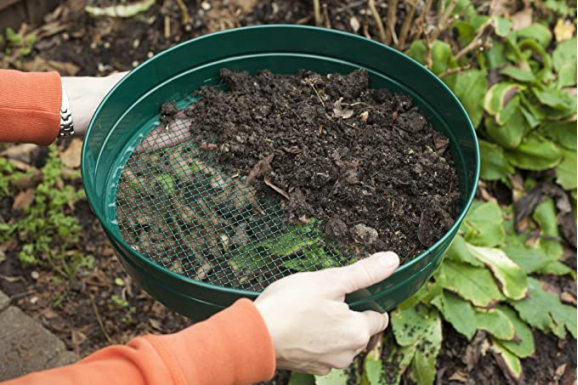
When it comes to soil sieving, garden sieve soil sifter is always the way to go.
Whether you’re a professional landscaper or just a hobby gardener, using garden sieve soil sifter is an easy and cost-effective way to quickly and accurately separate out your soil particles.
Let’s take a deep dive into this popular use for our garden sieve soil
What is garden sieve soil sifter
Garden sieve soil sifter is a practical tool used for soil screening. It consists of a frame and a mesh screen, with the frame typically being square or circular and the screen made of metal or plastic with small holes or mesh openings. When using a garden sieve soil sifter, the soil to be screened is placed on the mesh screen, and by gently shaking or vibrating the sifter, larger debris and rocks are retained on top while finer soil particles pass through the openings and collect in a container or on the ground below. This process yields refined and fine soil that is suitable for planting, soil amendment, or creating seed starting mixes. Garden sieve soil sifters are highly useful in gardening and cultivation, as they help remove impurities, improve soil texture, and provide an optimal environment for plant growth. They are also effective in removing weed roots and pest infestations, ensuring better conditions for plants.
How Does garden sieve soil sifter work?
A garden sieve soil sifter works by separating soil particles of different sizes through the use of a mesh screen. Here's how it works:
Preparation: Place the garden sieve soil sifter on a stable surface or support it with a frame if necessary.
Loading: Add the soil or compost mixture to be sifted onto the mesh screen of the sifter. It's usually more effective to work with smaller amounts of soil at a time.
Shaking or Agitating: Gently shake or agitate the garden sieve soil sifter from side to side or in a circular motion. This causes the soil to move across the mesh screen.
Sieving: As the soil moves across the mesh screen, the finer particles, such as loam or compost, will sift through the openings in the screen and fall into a container or onto the ground below. Meanwhile, larger debris, stones, and clumps will remain on top of the screen.
Repeat or Adjust: If necessary, repeat the process with the remaining soil until you have sifted all the desired soil. You can also adjust the sifter by using different mesh sizes or screens to achieve different levels of soil refinement.
The garden sieve soil sifter effectively separates the soil into different particle sizes, allowing you to remove larger debris and obtain finer, more refined soil. This process is particularly useful for creating a smooth planting medium, removing rocks and roots, and ensuring better soil quality for gardening and landscaping purposes.
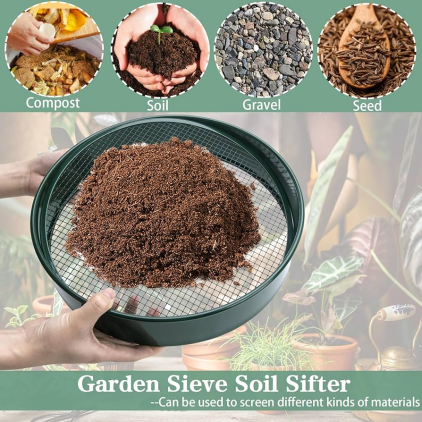
Benefits Of Using garden sieve soil sifter
Using a garden sieve soil sifter offers several benefits:
Removing impurities: A garden sieve soil sifter effectively removes debris, stones, roots, and other unwanted materials from the soil. This helps create a clean and pure soil environment, providing better growing conditions for plants.
Improving soil aeration and drainage: By sifting the soil, a garden sieve soil sifter refines the soil particles, increasing soil aeration and drainage. This prevents soil waterlogging and enhances oxygen supply to plant roots, promoting healthy root growth and development.
Providing a fine planting medium: Sifted soil is finer and free from larger particles, creating a suitable planting medium. This is beneficial for seed germination, seedling growth, and container gardening.
Disease and pest control: A garden sieve soil sifter helps eliminate soil-borne pathogens, insect eggs, and pests, reducing the occurrence and spread of diseases and pests. This contributes to maintaining plant health and reduces reliance on chemical pesticides.
Saving time and labor: Using a garden sieve soil sifter allows for quick and efficient sifting of large amounts of soil, saving time and labor compared to manual methods. It is a convenient tool, particularly for larger gardening projects.
In summary, the benefits of using a garden sieve soil sifter include removing impurities, improving soil texture, providing a fine planting medium, aiding in disease and pest control, and saving time and labor. It is an indispensable tool for gardening tasks.
Which Are The Most Popular Options
According to your requirements:
Material
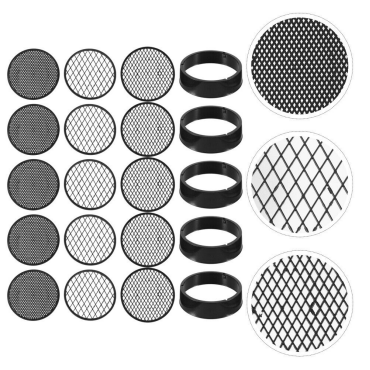
There are several types of metal garden sieves available. Here are some common types:
Stainless steel mesh: Stainless steel sieves are durable and resistant to corrosion. They are suitable for long-term use and can handle wet environments. Stainless steel mesh is often used for general gardening tasks.
Galvanized steel mesh: Galvanized steel sieves are coated with a layer of zinc, which enhances their corrosion resistance. They are durable and suitable for a wide range of gardening applications.
Copper mesh: Copper sieves are known for their excellent corrosion resistance and conductivity. They are often used for specialized gardening projects or specific screening needs.
Aluminum mesh: Aluminum sieves are lightweight and offer good corrosion resistance. They are ideal for portable gardening tasks that require easy handling and transportation.
Brass mesh: Brass sieves are made from a combination of copper and zinc. They are corrosion-resistant and suitable for general gardening purposes.
Iron mesh: Iron sieves are robust and can handle coarse screening tasks. However, they are prone to rust and require maintenance to prevent corrosion.
Ferrous metal mesh: Ferrous metal screens are usually made of iron or steel and are not subjected to special anti-corrosion treatments. These screens are suitable for one-off or short-term screening tasks, such as temporary soil screening or material screening on construction sites.
Shape
Square sieves: Square sieves are one of the most common shapes, featuring a square or rectangular sieve surface. They are suitable for general soil sifting tasks and can be conveniently placed on frames or supports for use.
Round sieves: Round sieves have a circular sieve surface. They typically have a central sieve hole with other sieve holes evenly distributed around the center. Round sieves can be used for various types of sifting needs in gardening.
Oval sieves: Oval sieves have an elliptical sieve surface. They fall between square and round shapes and are suitable for some specific sifting tasks.
Folding sieves: Folding sieves have a collapsible design, allowing for easy storage and portability. They are typically square or round and can be unfolded or folded as needed.
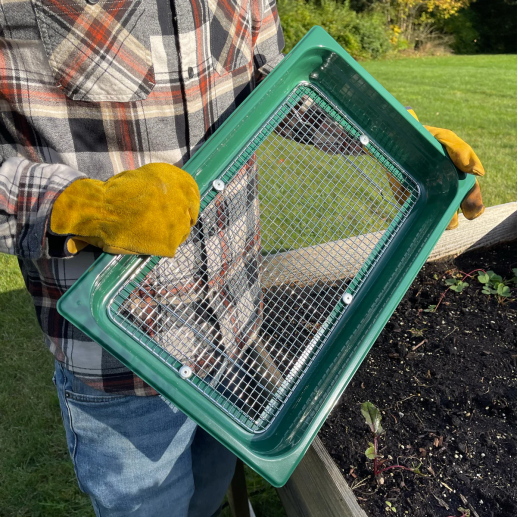
Hole Size
Garden sieve soil sifters come in various aperture sizes to accommodate different soil sifting needs. The choice of aperture size depends on the desired level of filtration or the size of particles you want to sift out. Here are some common aperture size classifications for garden sieve soil sifters:
Fine or Small: Fine or small aperture sizes are typically in the range of 0.1 to 1 millimeter (mm). These sifters are suitable for tasks that require fine filtration, such as removing small pebbles or debris from soil.
Medium: Medium aperture sizes range from 1 to 5 mm. They are commonly used for general soil sifting tasks, allowing for efficient removal of larger particles while retaining the desired soil consistency.
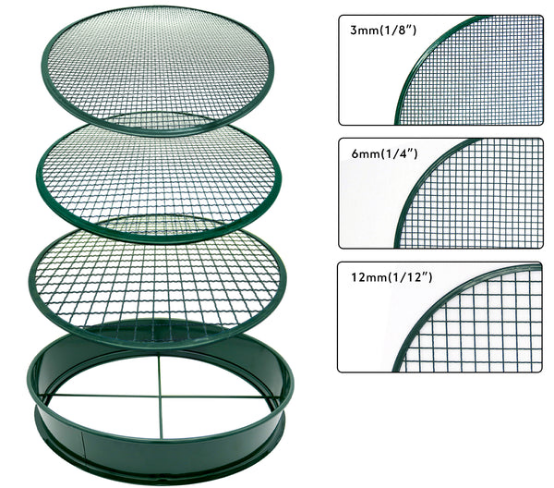
Coarse: Coarse aperture sizes are typically between 5 to 10 mm or larger. They are suitable for tasks that require the sifting of larger stones, rocks, or debris from the soil.
To choose the right garden sieve soil sifter, consider the following factors:
Filtering requirements: Determine your specific filtering needs. Do you want to remove small stones and debris, or do you require finer sifting, such as removing fine sand or small particles? Determine the required aperture size based on your filtering needs.
Soil type: Consider the type of soil you will be working with. Some soils may have larger particles, while others may be finer. Choose an appropriate sieve aperture size to effectively sift the desired particle size.
Material and durability: Select a garden sieve soil sifter made from durable materials to withstand frequent use and outdoor conditions. Stainless steel and galvanized steel are often durable and corrosion-resistant options.
Size and portability: Consider the size and weight of the sieve. Choose a sieve size that suits your needs and is convenient to carry and operate in your garden, based on your requirements and the intended usage environment.
User reviews and brand reputation: Check user reviews and feedback to learn about the performance and durability of different brands and models of garden sieve soil sifters. Choose reputable brands and popular models with verified quality and reliability.
Taking into account these factors and considering your specific needs and budget, select the appropriate garden sieve soil sifter.
Previous:Unlock Your Garden's Potential: Elevate Your Green Space with Garden Beds!
Next:The Allure and Utility of the Kitchen Food Storage Container Canister Set: A Comprehensive Guide